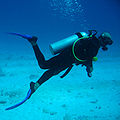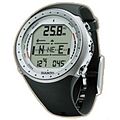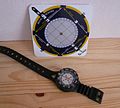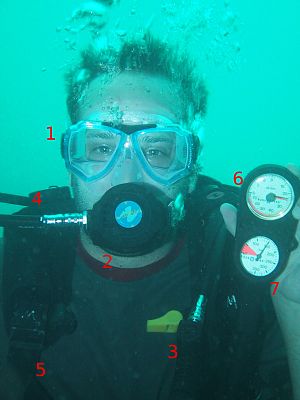- Diving equipment
-
Diving equipment 
Surface supplied commercial diving equipment on display at a trade showDiving equipment is equipment used by underwater divers for the purpose of facilitating diving activities. This may be equipment primarily intended for this purpose, or equipment intended for other puprposes which is found to be suitable for diving use.
Equipment which is used for underwater work or other activities which is not directly related to the activity of diving, or which has not been designed or modified specifically for underwater use by divers is excluded.
The fundamental item of diving equipment used by divers is underwater breathing apparatus, such as scuba equipment, and surface supplied diving equipment, but there are other important pieces of equipment that make diving safer, more convenient or more efficient.
Contents
Classes of underwater breathing apparatus
- Surface supplied diving - mostly used in professional diving. This category includes:
-
- Surface oriented surface supplied diving (Bounce diving), where the diver starts and finished the dive at normal atmospheric pressure.
- Saturation diving, where the diver remains under pressure in a underwater habitat or saturation spread between underwater excursions.
- Standard diving dress - mostly used in professional diving. Mainly of historical interest now.
- Airline or Hookah diving.
- "Compressor diving" - a rudimentary form of surface supplied diving used in the Philippines by artisanal fishermen.
- Recreational forms like snuba.
- Scuba diving - The use of self contained underwater breathing apparatus. This category includes:
-
- Open-circuit scuba consisting of diving cylinder(s) and diving regulator(s)
- Rebreather, closed-circuit or semi-closed-circuit scuba
- Free diving or breathhold diving, where the diver completes the dive on a single breath of air taken at the surface before the dive.
-
- Snorkel allows breathing at the surface with the face submerged, and is used as an adjunct to free diving and scuba.
- Atmospheric diving suits and other submersibles which isolate the diver from the ambient environment. These are not considered here.
- Liquid breathing systems are extremely rare and at an early experimental stage. It is hoped that some day practical systems allow very deep diving. This is not considered here.
-
A US Navy diver at work. The umbilical supplying air from the surface is clearly visible
-
Free-diver with monofin, ascending
-
The Newtsuit is an atmospheric diving suit which has fully articulated, rotary joints in the arms and legs.
Personal diving equipment
This is the diving equipment worn by or carried by the diver for personal protection or comfort, or to facilitate the diving aspect of the activity, and may include a selection from:
Underwater breathing apparatus
- Scuba equipment: Primary cylinder(s) and open circuit regulator(s), or rebreather sets. Alternative air source such as bailout bottle or pony bottle, and decompression cylinders and their associated regulators.
- Surface supplied equipment: Helmet or full face mask, bailout block, bailout cylinder and regulator.
Exposure protection
Thermal, sting and abrasion protection.
- In cold water, a diving suit such as a dry suit (at temperatures of 0-10°C), a wet suit (at temperatures of 21-25°C), or a Hot water suit (surface supplied diving only).
- Boiler suit overalls are often worn over the thermal protection suit by commercial divers as abrasion protection
- In very warm water (temperatures of 26-30°C), many types of tough, long, everyday clothing provide protection, as well as purpose made garments such as dive skins (made of lycra) and shorty wetsuits. In some cases, simple regular swimsuits are also used.[1]
- Diving gloves
- Diving hoods
- Diving boots - With dry suits, the boots are usually integrated.
- Safety helmet for scuba diving. (Not part of the breathing apparatus. May have a built-in forehead light. Images at [1].)
- Diving chain mail may be used as protection against bites by large marine animals
- Diver's cages may be used as protection against large predators
In-water stabilisation and movement
- A backplate is a structural device linking the buoyancy of the wing with the weight of the diving cylinders and harnessed around the diver's body
- Buoyancy compensator, Buoyancy Control Device, BCD or BC - many names for a buoyancy adjusting and life-saving buoyancy device
- Diver Propulsion Vehicle - to increase the range of the diver underwater
- Diving weighting system - to counteract the buoyancy of the diving suit and diver to allow descent. Professional divers may use additional weighting to ensure stability when working on the bottom
- Fins for efficient propulsion
- Depth gauge lets the diver monitor depth, particularly maximum depth and, when used with a watch and Decompression tables, also allows the diver to monitor decompression requirements. Some digital depth gauges also indicate ascent rate which is an important factor in avoiding decompression sickness
- Pneumofathometer is the surface supplied diving depth gauge which displays the depth of the diver at the surface control panel.
- Dive Computer helps the diver to avoid decompression sickness by indicating the decompression stops needed for the dive profile. Most dive computers also indicate depth, time and ascent rate. Some also indicate oxygen toxicity exposure and water temperature.
- Diving watch is used with depth gauge for decompression monitoring on decompression tables.
- Compass for underwater navigation.
- Submersible pressure gauge, also known as a "contents gauge" is used to monitor the remaining breathing gas supply in scuba cylinders.
- Distance line can used to guide the diver back to the start point and safety in poor visibility.
-
- A cave line is a line laid by a diver while pnetrating a cave to ensure that the way out is known. Permanent cave lines are marked with line markers at all junctions, indicating the direction along the line toward the nearest exit.
-
A depth gauge and submersible pressure gauge
-
Uwatec Aladin Pro dive computer showing the log of a previous dive
Vision and communication
- Mask allows the diver to see clearly underwater and protects the eyes.
- Full face mask protects the face from dirty or cold water and increases safety by securing the gas supply to the diver's face. If it contains no mouthpiece, the diver can talk allowing the use of communications equipment.
- Diving helmets are often used with surface supplied diving. They provide the same benefits as the full face mask but provide a very secure connection of the gas supply to the diver and additionally protect the head.
- Underwater writing slates and pencils are used to transport pre-dive plans underwater, to record facts whilst underwater and to aid communication with other divers.
- Torches or flashlights are essential for safety in low visibility or dark environments such as night diving and wreck and cave penetration. They are useful for communication and signalling both underwater and on the surface at night. Divers need artificial light even in shallow and clear water to reveal the red end of the spectrum of light which is absorbed as it travels through water.
- Hand-held sonar for a diver.
Safety equipment
- Diver's safety harness
- Lifeline
- Surface marker buoy
- Cutting tool
-
- Knife to cut lines, nets or to pry or dig. Can also be used for personal protection against underwater predators if needed, however not recommended as generally ineffective.
- Diver's net or line cutter. This is a small handheld tool carried by scuba divers to extricate themselves if trapped in fishing net or fishing line. It has a small sharp blade such as a replaceable scalpel blade inside the small notch. There is a small hole at the other end to for a lanyard to tether the cutter to the diver.
-
Gerber River Shorty, a river/diving knife, with serrated edge for cutting lines and straps, and a blunt tip for prying
Personal tools and accessories
- Camera, strobe (flash), video lights and housing - for underwater photography or underwater videography
- Diving reel or spool to store and transport a distance line or line for a surface marker buoy
- Diving shot consisting of a weight, line and buoy used to mark the location of a dive site, allowing divers to navigate to and from the surface and to do decompression stops at a safe location
- Dry box to hold objects the diver needs to keep dry at depth (wallet, cell phone)
Surface detection aids
The purposes of this class of personal equipment are to:
- allow the support boat to monitor and find divers on the surface during or after a dive
- prevent the diver being struck by boat traffic
- mark the diver's position when drift diving or while at the decompression stop
- help rescue services in lifeboats and helicopters to locate the diver
Surface detection aids include:
- Surface marker buoy, decompression buoy, delayed SMB, safety sausage or blob
- Red or yellow collapsible flag - high visibility, robust, usually stored bungeed to cylinder
- Whistle - cheap, will only be heard by people far from engine noise
- Torch or flashlight - if at sea after nightfall
- Strobe light - needs long-lasting batteries
- High pressure whistle - expensive but effective
- Orange water dye - increases diver's visibility from search helicopters
- Mirror such as a used compact disc - to reflect sunlight or searchlights
- Red pyrotechnic flares - for helicopters and lifeboats
- ENOS Rescue-System
- Emergency position-indicating rescue beacon (EPIRB)
- Glow stick - for night diving
Diving team tools and equipment
- A jackstay is a line laid along the bottom to guide the diver during a search or to and from the workplace.
- Lifting bags, an item of diving equipment consisting of a robust and air-tight bag with straps, which is used to lift heavy objects underwater by means of the bag's buoyancy when filled with air.
- Shot lines are used to identify the ascent and descent point and to help control rate of ascent and descent.
- Decompression trapeze is used to assist in maintaining correct depth during in-water decompression stops
- Diving bells and diving stages
Surface equipment connected with diving and underwater work
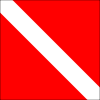 Informal Recreational diving flag
Informal Recreational diving flag
- Diver down flag is flown warning others that divers are underwater
- Diving air compressor to fill diving cylinders with high pressure air or other gasses
- Surface supplied diving breathing gas supply system, including:
- Boats such as the rigid-hulled inflatable boat
- Echo sounder - a Sonar depth measuring and profiling device used for dive site location
- GPS receiver - for locating dive sites
- Proton magnetometer - for locating ferrous wrecks
- Marine VHF radio - for communicating with rescue services and other boats
- Saturation systems providing surface support for saturation diving.
- Diving chambers for surface decompression and treatment of decompression illness
- Diving support vessels
Special equipment for underwater work not carried by the diver
- Remotely operated underwater vehicle - for locating dive sites
Illustration
This picture shows some of the basic diving equipment and controls:
- 1) the diving mask
- 2) the demand valve of the diving regulator
- 3) the buoyancy compensator inflation and vent valves
- 4) an alternate buoyancy compensator vent valve
- 5) shoulder straps of the BCD, which can be released by another diver in case of emergency
- 6) a depth gauge - showing 23 metres
- 7) the contents gauge displaying remaining pressure in the diving cylinder - showing 150 bar
See also
References
- ^ Go scuba dive by Monty Halls
Underwater diving Types: 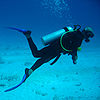
Specialities: Equipment: Disciplines: Professional diving · Police diving · Military diving · Underwater photography · Underwater videographyHazards: Related: Categories:
Wikimedia Foundation. 2010.



